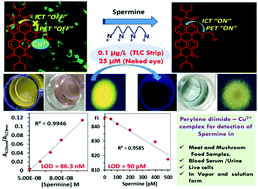Perylene diimide–Cu2+ based fluorescent nanoparticles for the detection of spermine in clinical and food samples: a step toward the development of a diagnostic kit as a POCT tool for spermine†
Abstract
The sustainable development of point-of-care testing (POCT) for spermine detection is important to check for food spoilage, early diagnosis of various malignancies and diminished anticonvulsant drug carbamazepine response in chronic epilepsy. Herein, the synthesis, characterization and spectroscopic properties of perylene diimide EA-PDI∩Cu2+ complex based nanoparticles towards spermine were studied in detail. This EA-PDI∩Cu2+ complex can be used for the ultrasensitive detection of spermine as low as 86.3 nM (UV-vis) and 90 pM (fluorescence) in aqueous medium, in urine and blood serum samples (recovery 99 ± 3) and in the solid state (0.1 μg L−1), and EA-PDI shows minimal cytotoxicity to cells and can easily enter into Human Osteosarcoma MG-63 cells for bio-imaging of Cu2+ and spermine. This EA-PDI∩Cu2+ complex can be established as a cost-effective method to develop a diagnostic kit for POCT of spermine in terms of a solution-based test kit for real time detection of spermine in vapor and solution form released from fermented food samples.



 Please wait while we load your content...
Please wait while we load your content...